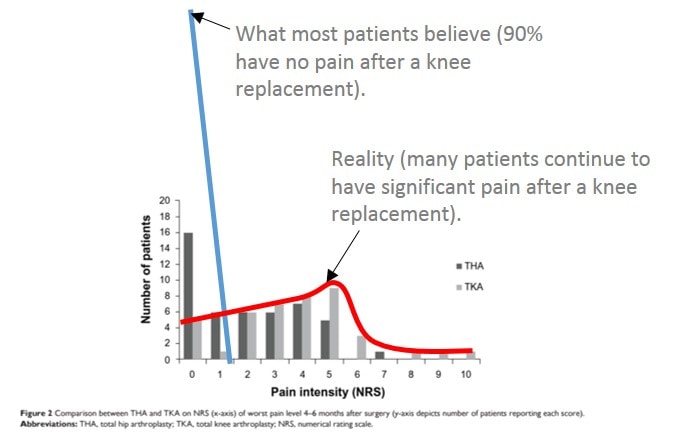Knee Replacement Recovery: Lots of Persistent Pain in Knee and Hip Replacement Patients
The Reality of Knee Replacement Recovery
What does the reality of knee replacement recovery look like? Most patients I meet when discussing a knee replacement believe that the vast majority of their pain will go away after a knee replacement. So what’s reality? Regrettably, we haven’t had good research showing how patients fare after knee replacement. However, a recent study is very scary if you’re contemplating a knee replacement, as the pain data after this huge surgery doesn’t look pretty.
So you’ve put up with the severe surgical risks involved in knee replacement such as a dramatically increased risk of heart attack following surgery. What can you expect? A recent study that looked at 100 patients paid strict attention to patient’s pain complaints right around the time most surgeons claim that you should be getting your maximum improvement from the surgery-4-6 months after the procedure. Regrettably, this study showed that 67% of hip replacement patients and a whopping 89% of knee replacement patients were still in pain! How much pain? Look at the graph above I took from the article and annotated. The bars numbered 0-10 represent post-op pain scores that the patients reported and the y-axis (height of the bar) represents how many patients have that pain score. For the hip replacement patients, while many patients still have significant pain, at least the bar is highest on the 0/10 pain (no pain) side. However, for the knee replacement patients, the bar is actually highest at 5/10-which is still moderate pain (not that much different from what most patients would describe before the surgery). My annotations show where the bars should be if the pain data actually matched what most patients believe (a very tall 0/10 bar with maybe a smaller 1/10 bar-blue line) versus what’s actually reported (red line). This data is also consistent with other studies showing continued pain after knee replacement.
But Why Would the Reality of Knee Replacement Recovery Have So Many Patients Still in Pain?
Why should so many patients still be in significant pain after the painful knee joint was removed? There’s a clue in the data. For 77% of the knee replacement patients their pain was described as numbness. To me, this means that their knee pain was likely coming from a pinched nerve and not the knee joint itself. This is consistent with newer data showing that nerve issues lead to pain and arthritis and not the other way around (structural changes don’t cause pain, pain is caused by bad nerves). Where could this pinched nerve be? Given the average age range for knee replacement patients, it’s most likely to be their low back.
Avoid the Reality of Knee Replacement Recovery Pain with Thorough Exam First
The upshot? To me this data is frightening if you’re considering a knee replacement and therefore the resultant knee replacement recovery. This is a huge surgery with huge risks and for most patients to end up with 5/10 pain isn’t what they signed up for. In addition, the fact that most of the residual pain is described as numbness means to me that our medical care system is missing patients with knee pain caused primarily by nerve and not joint issues. Having seen patients in this boat, this seems to happen when the decision to operate and replace the knee joint is based on a cursory exam and the results of a knee x-ray without ever investigating if the knee pain may not be from the knee.

NOTE: This blog post provides general information to help the reader better understand regenerative medicine, musculoskeletal health, and related subjects. All content provided in this blog, website, or any linked materials, including text, graphics, images, patient profiles, outcomes, and information, are not intended and should not be considered or used as a substitute for medical advice, diagnosis, or treatment. Please always consult with a professional and certified healthcare provider to discuss if a treatment is right for you.

